We were invited to proposed a constructive system that aims to collaborate in the maintenance of the Brazilian indigenous culture and provide them a flexible space for a multi propose use space.
The first of the tree sites that the project will be implemented is the new Kisêdjê village. It’s recent construction is due to a forced displacement carried out by the community, aiming to escape from the agrochemicals used in the soybean plantations that surround and advance daily into the indigenous territory.

Native village at Xingu National Park, São Félix do Araguaia MT Brasil, 2017
Foto / photo Pedro Kok
The community is built around a central square, the large common area of the village. Their homes are called oca and are basically the same building with small variations. The ocas are made with overlaid wood pieces and covered with straws, no internal compartmentalisation is needed, the only room is divided exclusively by a shadow gradation.

Native village at Xingu National Park, São Félix do Araguaia MT Brasil, 2017
Foto / photo Gustavo Utrabo
However, in addition to the political aspects, there is, in this context a complex relationship between the indigenous culture, that struggles to maintain itself, but also to adapt to the new moment. Industrialised products, of low quality and difficult discard or reuse are seen all around the village, showing the transformation of the traditional habits.

Native village at Xingu National Park, São Félix do Araguaia MT Brasil, 2017
Foto / photo Gustavo Utrabo
In this tension between industrialised elements and natural resources the project is inserted, not as an attempt to replicate a culture, but as an element that tries to stress and expose the richness of the Brazilian indigenous culture.
In such conditions, a flexible system is designed, aiming replicability, easy construction, low cost and comfort. Eight main pieces are combined and allow a simple structural arrangement, capable of receiving different spatial fractions, according to the needs of each village.

Xingu Canopies, isometric perspective of the building system, Xingu National Park, São Félix do Araguaia MT Brasil, 2017. Architect Gustavo Utrabo (author) / Estúdio Gustavo Utrabo
Imagem divulgação / disclosure image [Estúdio Gustavo Utrabo]
The simplicity of the project is also due to the impossibility to have contact with the construction site during the building process, to minimize possible doubts of the local builders, models and didactic drawings are carried out to quickly transmit the constructive processes.
A large internal area in which a classroom, a space for collective meals, an auditorium or any other function can happened. Opening devices allow different atmospheres.
A shaded space is created to accommodate different complementary functions and create an expanded boundary.
Due to the constante mobility of Brazilian indigenous communities, the structure is put together thought scrolls, in an attempt to expand the building live.

Xingu Canopies, physical model, Xingu National Park, São Félix do Araguaia MT Brasil, 2017. Architect Gustavo Utrabo (author) / Estúdio Gustavo Utrabo
Foto / photo Gustavo Utrabo
data sheet
project
Xingu Canopies
site
Xingu National Park, São Félix do Araguaia MT Brasil
built area
368,25 m2
architecture
Gustavo Utrabo (author), Beatriz Rocha (team) / Estúdio Gustavo Utrabo
structural project
Ita Construtora
project year
2017
construction year
2017
client
Instituto Sócio Ambiental – ISA
photo
Gustavo Utrabo / Pedro Kok



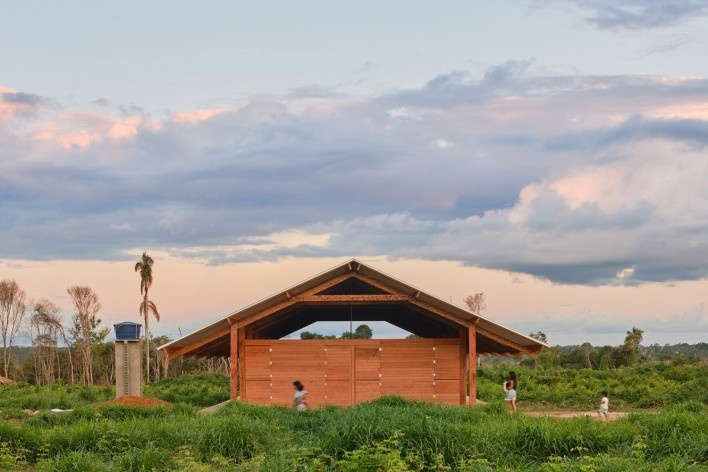
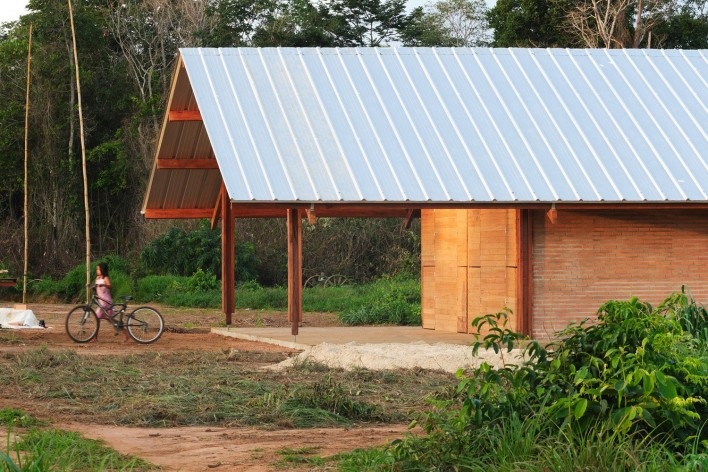
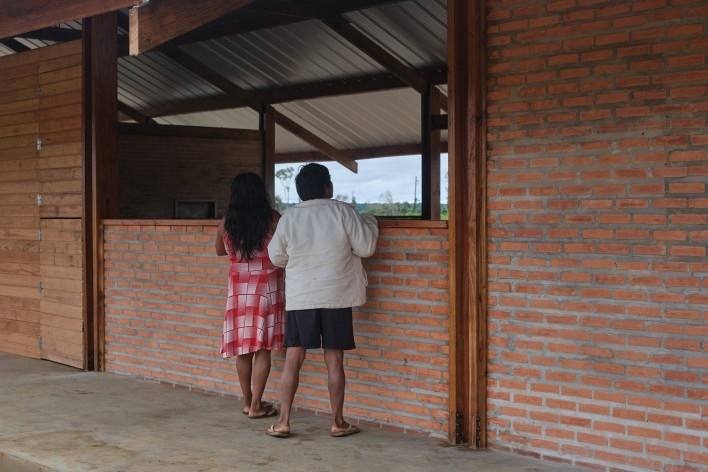
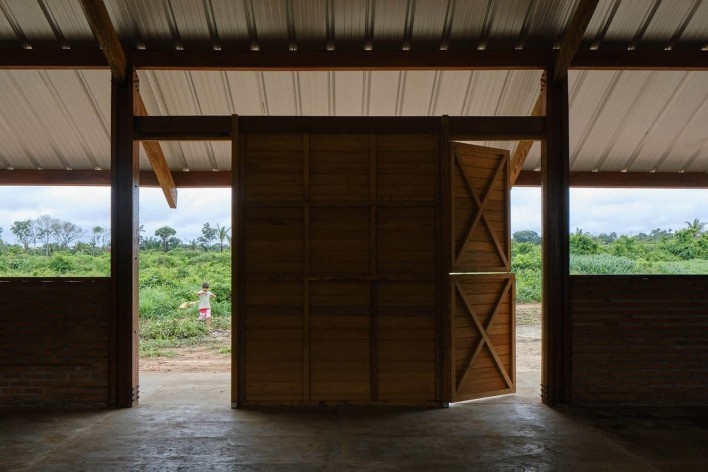
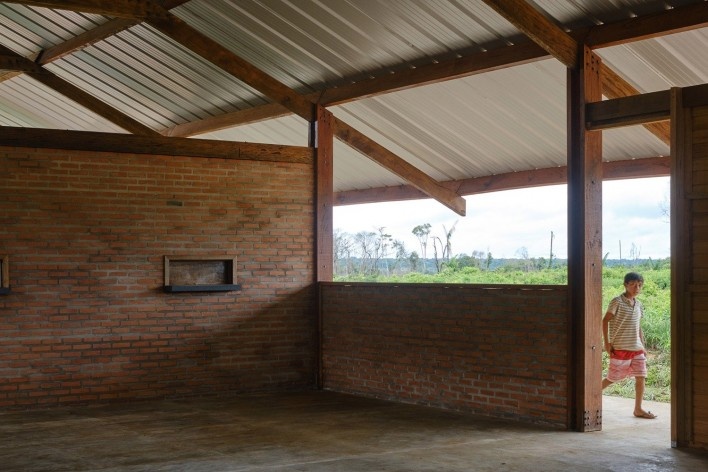
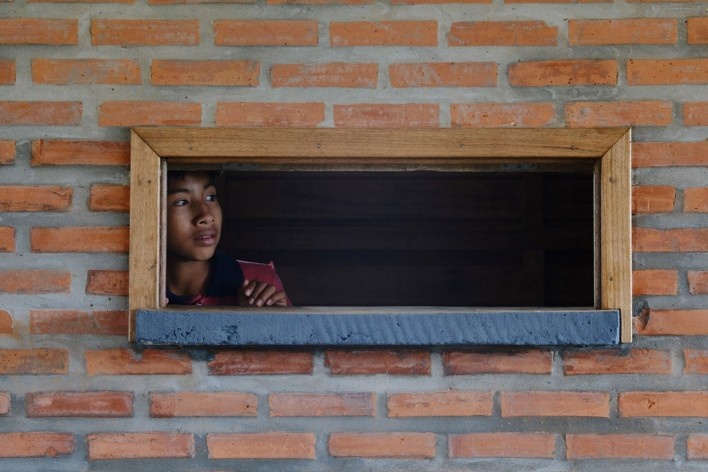
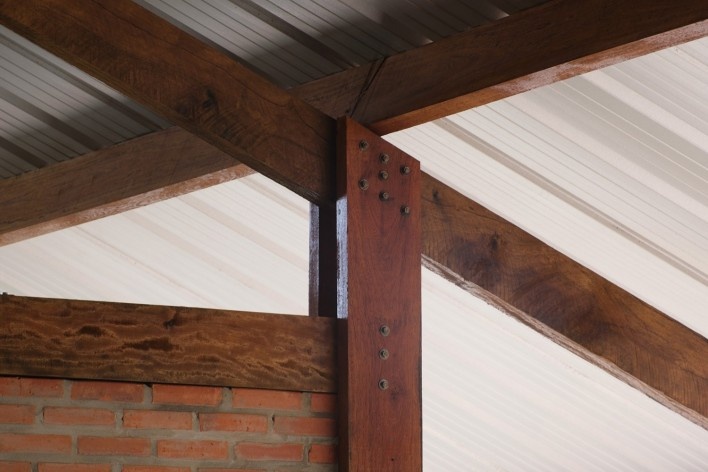
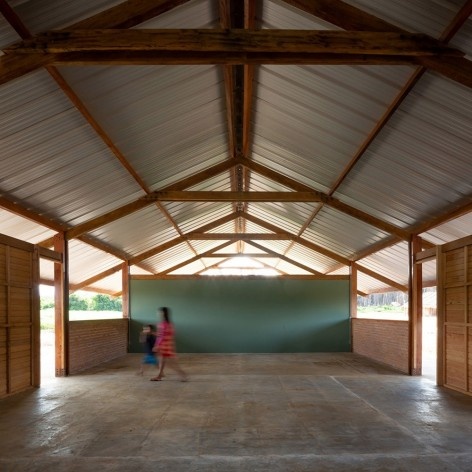
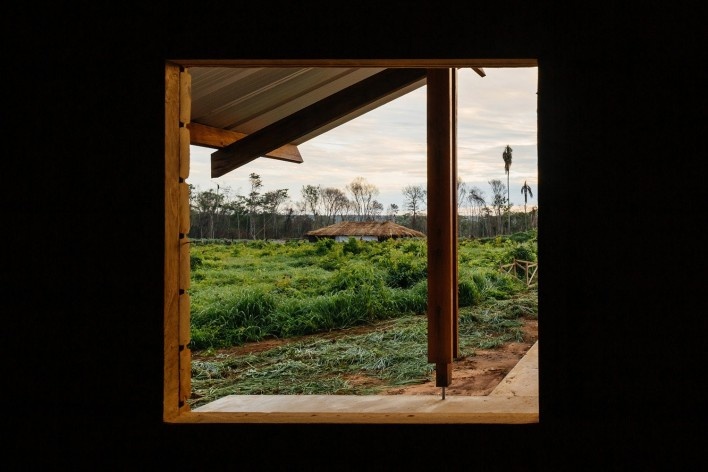
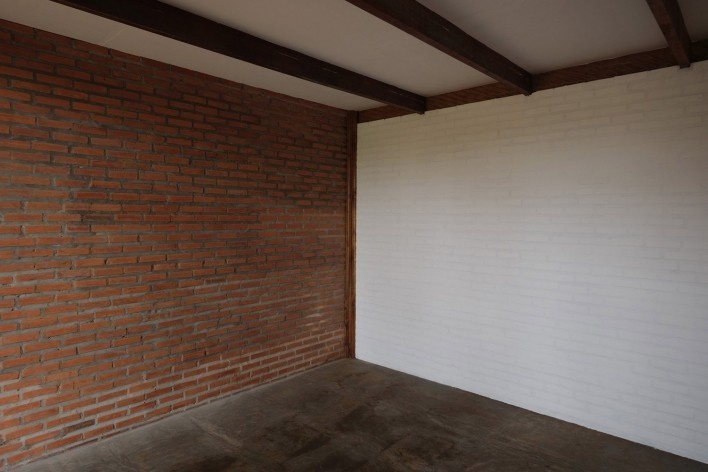
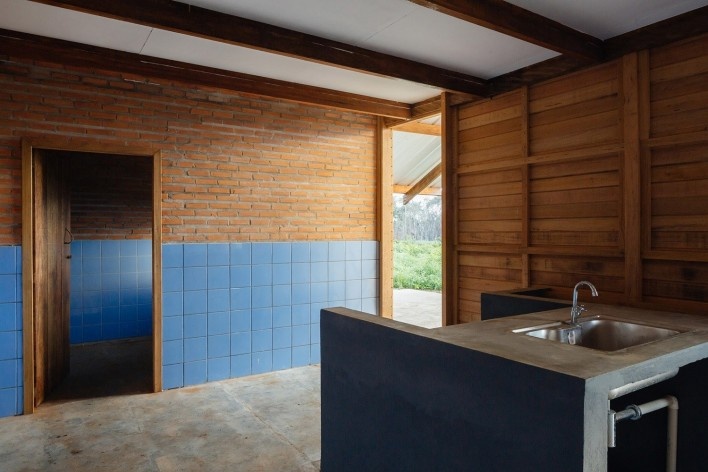
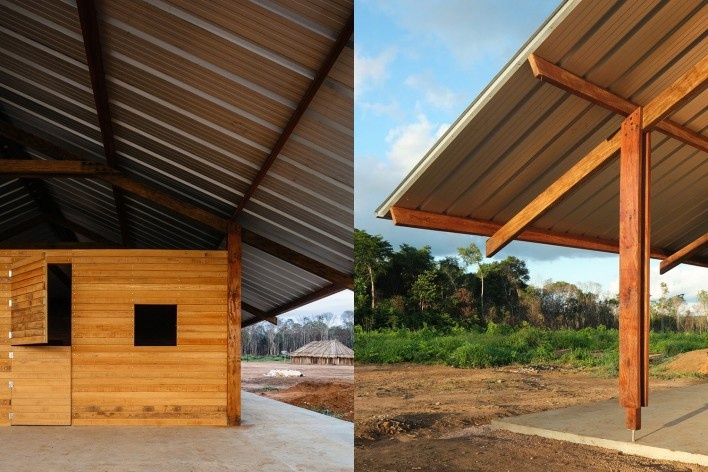
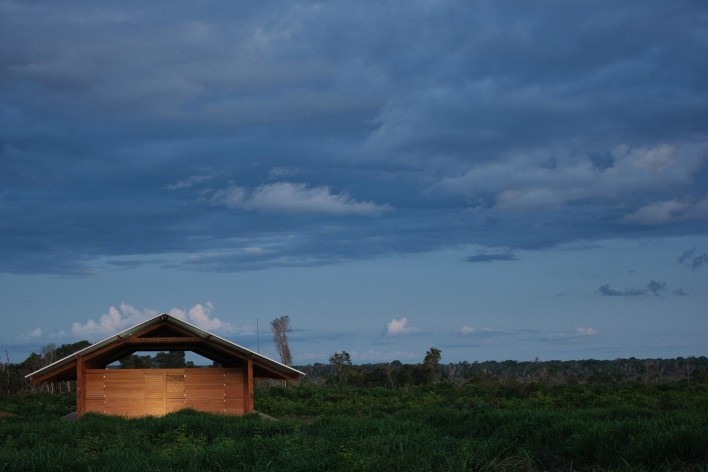
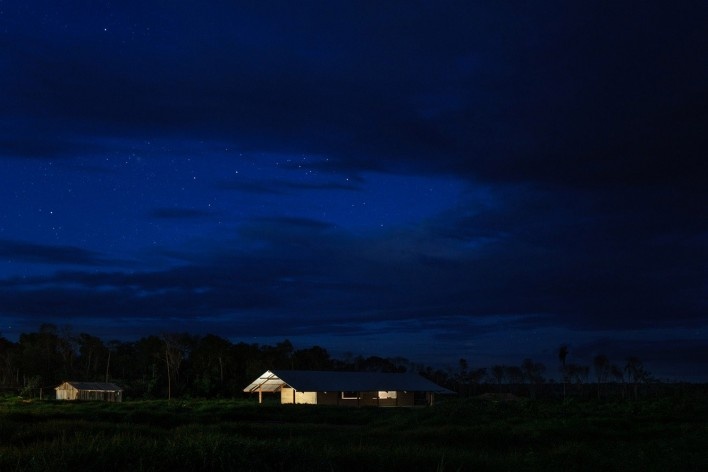
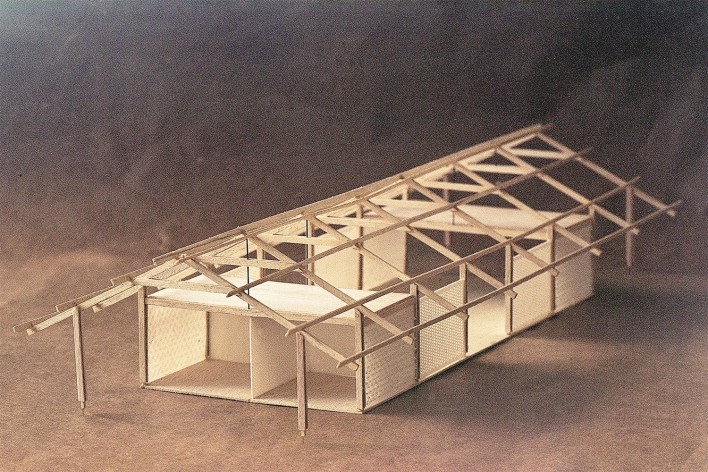
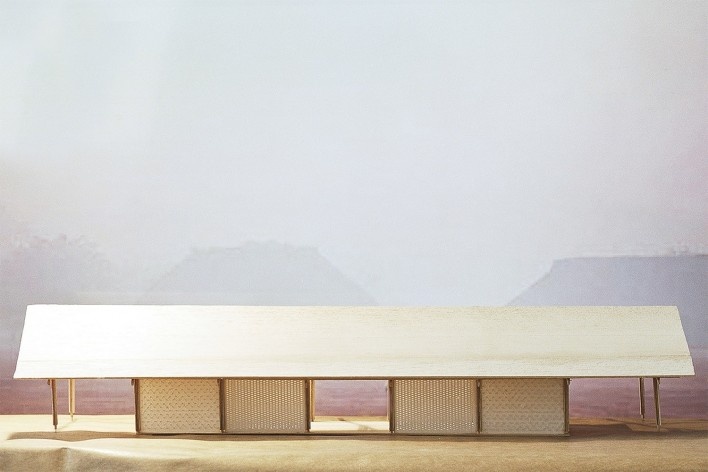
![Xingu Canopies, site plan perspective, Xingu National Park, São Félix do Araguaia MT Brasil, 2017. Architect Gustavo Utrabo (author) / Estúdio Gustavo Utrabo<br />Imagem divulgação / disclosure image [Estúdio Gustavo Utrabo]](https://vitruvius.com.br/media/images/magazines/grid_12/52b3238cfe8a_utrabo_xingu22.jpg)
![Xingu Canopies, floor plan, Xingu National Park, São Félix do Araguaia MT Brasil, 2017. Architect Gustavo Utrabo (author) / Estúdio Gustavo Utrabo<br />Imagem divulgação / disclosure image [Estúdio Gustavo Utrabo]](https://vitruvius.com.br/media/images/magazines/grid_12/2096a8c73887_utrabo_xingu23.jpg)
![Xingu Canopies, rooftop plan, Xingu National Park, São Félix do Araguaia MT Brasil, 2017. Architect Gustavo Utrabo (author) / Estúdio Gustavo Utrabo<br />Imagem divulgação / disclosure image [Estúdio Gustavo Utrabo]](https://vitruvius.com.br/media/images/magazines/grid_12/8c5bea2ebb7f_utrabo_xingu24.jpg)
![Xingu Canopies, sections, Xingu National Park, São Félix do Araguaia MT Brasil, 2017. Architect Gustavo Utrabo (author) / Estúdio Gustavo Utrabo<br />Imagem divulgação / disclosure image [Estúdio Gustavo Utrabo]](https://vitruvius.com.br/media/images/magazines/grid_12/c1d9a363baa1_utrabo_xingu25.jpg)
![Xingu Canopies, isometric perspective of mounting system, Xingu National Park, São Félix do Araguaia MT Brasil, 2017. Architect Gustavo Utrabo (author) / Estúdio Gustavo Utrabo<br />Imagem divulgação / disclosure image [Estúdio Gustavo Utrabo]](https://vitruvius.com.br/media/images/magazines/grid_12/3aa8bf272c14_utrabo_xingu26.jpg)
![Xingu Canopies, details, Xingu National Park, São Félix do Araguaia MT Brasil, 2017. Architect Gustavo Utrabo (author) / Estúdio Gustavo Utrabo<br />Imagem divulgação / disclosure image [Estúdio Gustavo Utrabo]](https://vitruvius.com.br/media/images/magazines/grid_12/133c2485f7e0_utrabo_xingu27.jpg)
![Xingu Canopies, details, Xingu National Park, São Félix do Araguaia MT Brasil, 2017. Architect Gustavo Utrabo (author) / Estúdio Gustavo Utrabo<br />Imagem divulgação / disclosure image [Estúdio Gustavo Utrabo]](https://vitruvius.com.br/media/images/magazines/grid_12/58b8de544a26_utrabo_xingu28.jpg)
![Xingu Canopies, details, Xingu National Park, São Félix do Araguaia MT Brasil, 2017. Architect Gustavo Utrabo (author) / Estúdio Gustavo Utrabo<br />Imagem divulgação / disclosure image [Estúdio Gustavo Utrabo]](https://vitruvius.com.br/media/images/magazines/grid_12/e17a56f8a78c_utrabo_xingu29.jpg)
![Xingu Canopies, details, Xingu National Park, São Félix do Araguaia MT Brasil, 2017. Architect Gustavo Utrabo (author) / Estúdio Gustavo Utrabo<br />Imagem divulgação / disclosure image [Estúdio Gustavo Utrabo]](https://vitruvius.com.br/media/images/magazines/grid_12/61762a93bd2f_utrabo_xingu30.jpg)
![Xingu Canopies, details, Xingu National Park, São Félix do Araguaia MT Brasil, 2017. Architect Gustavo Utrabo (author) / Estúdio Gustavo Utrabo<br />Imagem divulgação / disclosure image [Estúdio Gustavo Utrabo]](https://vitruvius.com.br/media/images/magazines/grid_12/0bd0ead3ce7f_utrabo_xingu31.jpg)
![Xingu Canopies, details, Xingu National Park, São Félix do Araguaia MT Brasil, 2017. Architect Gustavo Utrabo (author) / Estúdio Gustavo Utrabo<br />Imagem divulgação / disclosure image [Estúdio Gustavo Utrabo]](https://vitruvius.com.br/media/images/magazines/grid_12/36fa8bf08dcf_utrabo_xingu32.jpg)
![Xingu Canopies, details, Xingu National Park, São Félix do Araguaia MT Brasil, 2017. Architect Gustavo Utrabo (author) / Estúdio Gustavo Utrabo<br />Imagem divulgação / disclosure image [Estúdio Gustavo Utrabo]](https://vitruvius.com.br/media/images/magazines/grid_12/c3fec844b6f3_utrabo_xingu33.jpg)
![Xingu Canopies, details, Xingu National Park, São Félix do Araguaia MT Brasil, 2017. Architect Gustavo Utrabo (author) / Estúdio Gustavo Utrabo<br />Imagem divulgação / disclosure image [Estúdio Gustavo Utrabo]](https://vitruvius.com.br/media/images/magazines/grid_12/7a0f37af735e_utrabo_xingu34.jpg)
![Xingu Canopies, details, Xingu National Park, São Félix do Araguaia MT Brasil, 2017. Architect Gustavo Utrabo (author) / Estúdio Gustavo Utrabo<br />Imagem divulgação / disclosure image [Estúdio Gustavo Utrabo]](https://vitruvius.com.br/media/images/magazines/grid_12/d5f690297699_utrabo_xingu35.jpg)
















![Xingu Canopies, site plan perspective, Xingu National Park, São Félix do Araguaia MT Brasil, 2017. Architect Gustavo Utrabo (author) / Estúdio Gustavo Utrabo<br />Imagem divulgação / disclosure image [Estúdio Gustavo Utrabo]](https://vitruvius.com.br/media/images/magazines/gallery_thumb/52b3238cfe8a_utrabo_xingu22.jpg)
![Xingu Canopies, floor plan, Xingu National Park, São Félix do Araguaia MT Brasil, 2017. Architect Gustavo Utrabo (author) / Estúdio Gustavo Utrabo<br />Imagem divulgação / disclosure image [Estúdio Gustavo Utrabo]](https://vitruvius.com.br/media/images/magazines/gallery_thumb/2096a8c73887_utrabo_xingu23.jpg)
![Xingu Canopies, rooftop plan, Xingu National Park, São Félix do Araguaia MT Brasil, 2017. Architect Gustavo Utrabo (author) / Estúdio Gustavo Utrabo<br />Imagem divulgação / disclosure image [Estúdio Gustavo Utrabo]](https://vitruvius.com.br/media/images/magazines/gallery_thumb/8c5bea2ebb7f_utrabo_xingu24.jpg)
![Xingu Canopies, sections, Xingu National Park, São Félix do Araguaia MT Brasil, 2017. Architect Gustavo Utrabo (author) / Estúdio Gustavo Utrabo<br />Imagem divulgação / disclosure image [Estúdio Gustavo Utrabo]](https://vitruvius.com.br/media/images/magazines/gallery_thumb/c1d9a363baa1_utrabo_xingu25.jpg)
![Xingu Canopies, isometric perspective of mounting system, Xingu National Park, São Félix do Araguaia MT Brasil, 2017. Architect Gustavo Utrabo (author) / Estúdio Gustavo Utrabo<br />Imagem divulgação / disclosure image [Estúdio Gustavo Utrabo]](https://vitruvius.com.br/media/images/magazines/gallery_thumb/3aa8bf272c14_utrabo_xingu26.jpg)
![Xingu Canopies, details, Xingu National Park, São Félix do Araguaia MT Brasil, 2017. Architect Gustavo Utrabo (author) / Estúdio Gustavo Utrabo<br />Imagem divulgação / disclosure image [Estúdio Gustavo Utrabo]](https://vitruvius.com.br/media/images/magazines/gallery_thumb/133c2485f7e0_utrabo_xingu27.jpg)
![Xingu Canopies, details, Xingu National Park, São Félix do Araguaia MT Brasil, 2017. Architect Gustavo Utrabo (author) / Estúdio Gustavo Utrabo<br />Imagem divulgação / disclosure image [Estúdio Gustavo Utrabo]](https://vitruvius.com.br/media/images/magazines/gallery_thumb/58b8de544a26_utrabo_xingu28.jpg)
![Xingu Canopies, details, Xingu National Park, São Félix do Araguaia MT Brasil, 2017. Architect Gustavo Utrabo (author) / Estúdio Gustavo Utrabo<br />Imagem divulgação / disclosure image [Estúdio Gustavo Utrabo]](https://vitruvius.com.br/media/images/magazines/gallery_thumb/e17a56f8a78c_utrabo_xingu29.jpg)
![Xingu Canopies, details, Xingu National Park, São Félix do Araguaia MT Brasil, 2017. Architect Gustavo Utrabo (author) / Estúdio Gustavo Utrabo<br />Imagem divulgação / disclosure image [Estúdio Gustavo Utrabo]](https://vitruvius.com.br/media/images/magazines/gallery_thumb/61762a93bd2f_utrabo_xingu30.jpg)
![Xingu Canopies, details, Xingu National Park, São Félix do Araguaia MT Brasil, 2017. Architect Gustavo Utrabo (author) / Estúdio Gustavo Utrabo<br />Imagem divulgação / disclosure image [Estúdio Gustavo Utrabo]](https://vitruvius.com.br/media/images/magazines/gallery_thumb/0bd0ead3ce7f_utrabo_xingu31.jpg)
![Xingu Canopies, details, Xingu National Park, São Félix do Araguaia MT Brasil, 2017. Architect Gustavo Utrabo (author) / Estúdio Gustavo Utrabo<br />Imagem divulgação / disclosure image [Estúdio Gustavo Utrabo]](https://vitruvius.com.br/media/images/magazines/gallery_thumb/36fa8bf08dcf_utrabo_xingu32.jpg)
![Xingu Canopies, details, Xingu National Park, São Félix do Araguaia MT Brasil, 2017. Architect Gustavo Utrabo (author) / Estúdio Gustavo Utrabo<br />Imagem divulgação / disclosure image [Estúdio Gustavo Utrabo]](https://vitruvius.com.br/media/images/magazines/gallery_thumb/c3fec844b6f3_utrabo_xingu33.jpg)
![Xingu Canopies, details, Xingu National Park, São Félix do Araguaia MT Brasil, 2017. Architect Gustavo Utrabo (author) / Estúdio Gustavo Utrabo<br />Imagem divulgação / disclosure image [Estúdio Gustavo Utrabo]](https://vitruvius.com.br/media/images/magazines/gallery_thumb/7a0f37af735e_utrabo_xingu34.jpg)
![Xingu Canopies, details, Xingu National Park, São Félix do Araguaia MT Brasil, 2017. Architect Gustavo Utrabo (author) / Estúdio Gustavo Utrabo<br />Imagem divulgação / disclosure image [Estúdio Gustavo Utrabo]](https://vitruvius.com.br/media/images/magazines/gallery_thumb/d5f690297699_utrabo_xingu35.jpg)
